Clown Plecos are small comedians in the fish world. While loricariids are known to be shy and introverted, these smaller species are always ready to put on an entertaining show – just give them a bit of time to adjust to their new home.
However, you shouldn’t let their silly nature fool you. Clown Plecos are hardworking members of the “Grime Scene Investigators,” keeping your tank slime and algae-free one nibble at a time.
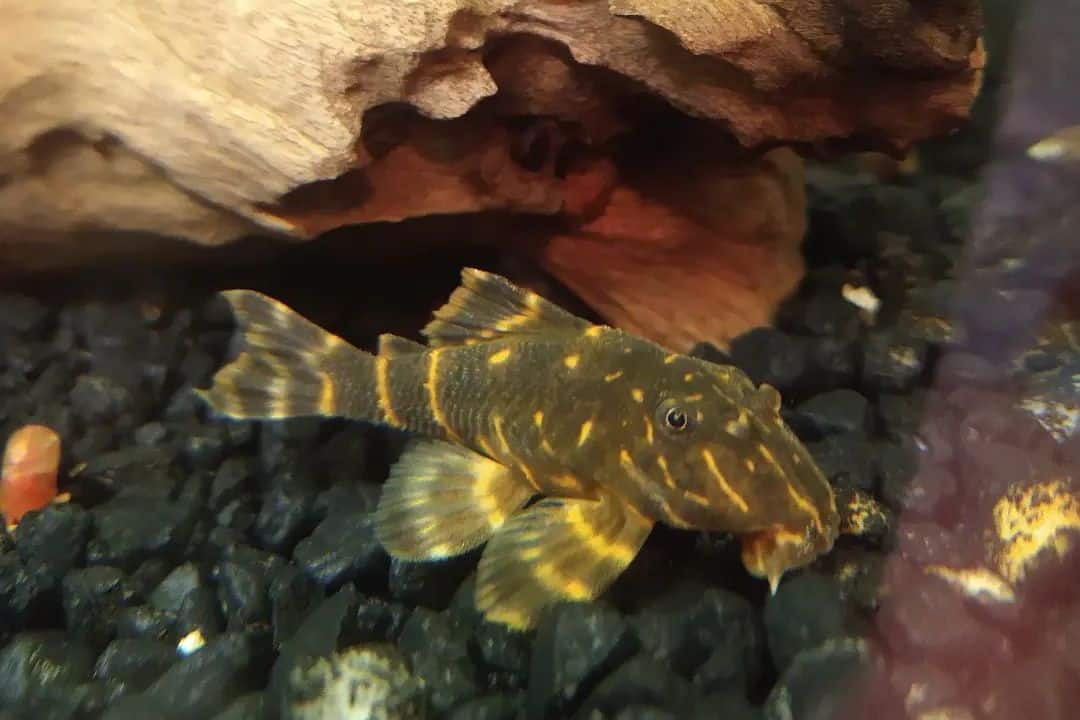
While Clown Plecos are not difficult to keep alive, they can be challenging to keep healthy. Many people believe these armored catfish can endure harsh water conditions, but this isn’t true.
The Clown Plecostomus also needs tender loving care from you. So if you’re interested in keeping one or two, keep scrolling and discover everything you need to know in this comprehensive guide.
Clown Pleco Natural Habitat and Origin
The Clown Plecostomus, scientifically known as Panaque maccus, is a member of the Loricariidae family that falls into the genus Panaqolus. The fish is commonly known as Clown Pleco, Clown Panaque, or Ringlet Pleco. Panaque, which is pronounced “pa-nah-KAY” translates to “pleco” in Venezuelan.
The Clown Pleco can also be identified using various “L” and number suffixes. “L” stands for Loricariidae, and the number that follows indicates a particular variant.
Using the L-system, the fish is commonly known as LDA22. Clown Plecos with a slightly wavy pattern are labeled L162, while those with a very wild stripe pattern are tagged L104.
In 1993, the P. maccus has gained formal recognition and is one of the most popular plecos in the aquarium trade.
Clown Plecos are endemic to Apuré and Caroní River basins in Venezuela. These river basins are overcrowded with decaying vegetation and driftwood due to the trees and shrubs along the shores.
Clown Pleco Overview
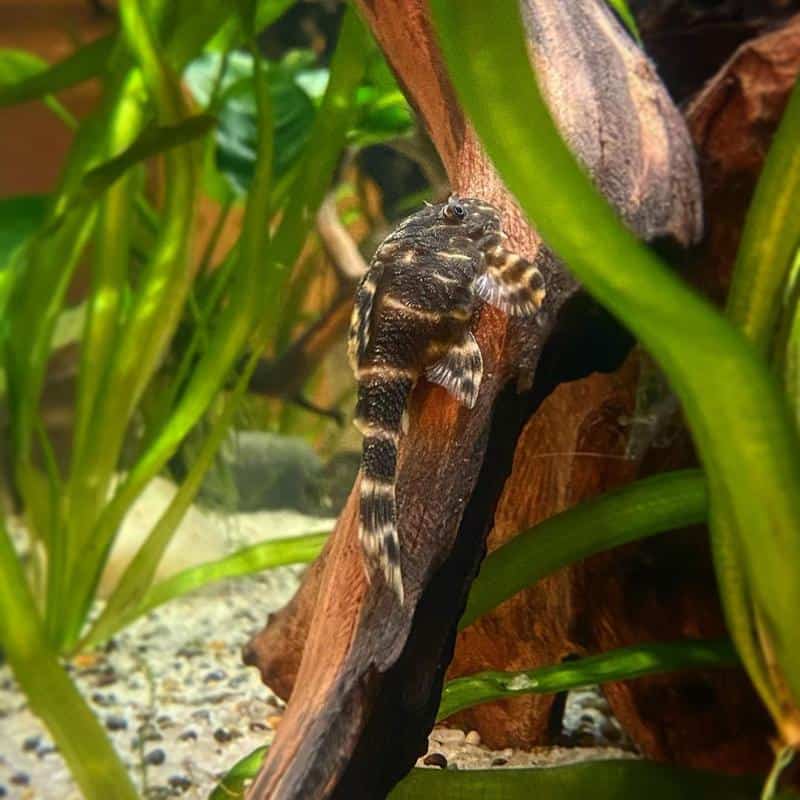
| Scientific Name | Panaque maccus |
| Size | 3.5-4 inches |
| Life Expectancy | 10-12 years |
| Temperament | Peaceful, nocturnal
More active than most species of suckermouth catfish |
| Diet | Omnivorous
Eats algae, driftwood, and fresh vegetables |
| Tank Size | 40 gallons |
| Tank Temperature | 72-80° F (22°-27° C) |
| Water Hardness | 10 dGH |
| Water pH | 6.8 to 7.6 |
Size and Growth Rate
Clown Plecos are great for beginners who don’t have large tanks. These catfish are only going to max out at 4 inches, but 3.5 inches is more common.
Appearance
As a member of the Loricariidae family, the P. maccus strikes a resemblance to other “armored” catfish.
Clown Plecos have a broad head that angles down to the bottom and a big rasping mouth on the underside that provides them a foothold on rocks and driftwood. The vertically oriented mouth is well-adapted for scraping algae.
Their thick bodies taper toward the caudal peduncle. They have large pectoral, dorsal, and caudal fins that can be folded down when at rest.
Interestingly, the patterns and vibrancy of the color change as the plecos age. Juveniles have a dark brown base color, while fully matured adults have a much lighter color and possess more cream to yellowish stripes.
Lifespan
If you want a pet fish that will stay with you for a long time, the Clown Plecostomus fits the bill. Clown Plecos can grace your tank for 10 to 12 years if you do your job right.
Behavior And Temerament
While Clown Plecos are not the most vibrant-looking fish, you can rest assured their colorful personalities will add life to your tank.
The Clown Plecostomus is a calm, mellow species that hides away during the day. The nocturnal loricariids wait for dusk to fall. As the noise and light dwindle, they would come out of their hideouts to rummage for food.
The P. maccus is less skittish and is more active than most loricariids. Of course, your fish may often hide at first as they are wary of their new environment. But after some time, they will come out more often and become more interactive with their surroundings.
Clown Plecos don’t cause trouble to other fish, but they do love their space. For the most part, Clown Plecos keep to themselves. They don’t bother with their tank mates while they mill around on the bottom.
Clown Pleco Tank Setup
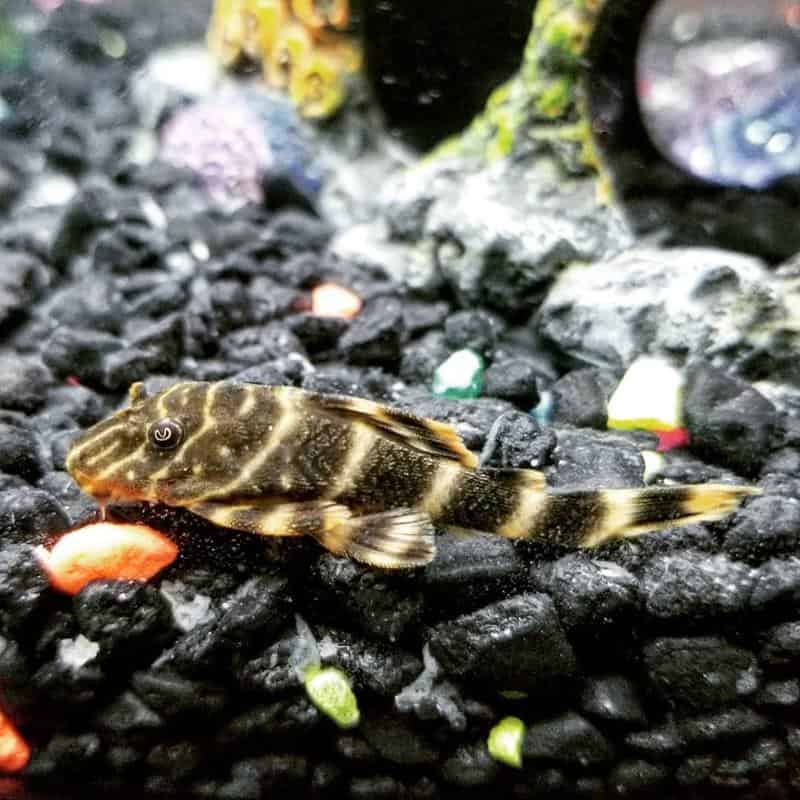
Tank Size
Some sources recommend as little as 20 gallons. True, the P. maccus has a small stature unlike common plecos, but I discourage you from settling for a tank that small.
I recommend that you acquire a 40-gallon tank or bigger. With a larger tank, it would be easier to control water parameters.
Plus, it offers plenty of viewing space. You’ll be able to watch your pleco interact with the underwater world that you’ve created that would be otherwise difficult to achieve with a smaller tank.
Don’t forget that Clown Plecos are bottom dwellers. A tank with more width than height will provide more room down below for your catfish.
Substrate
Avoid a bare bottom tank unless you are setting up a breeding tank for your Clown Plecos.
As these catfish spend a lot of time combing over the bottom for food, the best and safest substrate for them are soft sand, fine gravel, clay, or a combination of clay and gravel.
Seachem Flourite Dark and CaribSea Sunset Gold Sand are fine options should you wish to layer your tank with sand. Make sure the substrate is two inches thick.
But if you want to achieve the best planted tank for your Clown Plecos, Fluval Bio Stratum Gravel would be a great choice. It has a porous structure and a boatload of nutrients for optimal health in rooted plants.
Some aquarists choose a bare-bottomed tank with their plecos, but any live plants you keep in the aquarium will require a nutrient-rich substrate.
Plants and Decorations
Place rock formations and caves. These decorations will provide plecos shelter during the day. However, make sure not to go overboard which could otherwise reduce their swimming space.
Likewise, focus on live plants. An abundance of plants mimics their home in the wild. The best and safest plants for Clown Plecos are:
- Amazon Sword (Echinodorus Bleheri)
- Anubias (Anubias barteri)
- Java Fern (Microsorum pteropus)
- Eelgrass (Vallisneria americana)
- Water Trumpet (Cryptocoryne wendtii)
Since Clown Plecos come from murky waters, you’ll also want to add floating plants to subdue lighting. Duckweed and Amazon Frogbit would fit best.
You can also use Hornwort. Although it isn’t a true floating plant, it can stay suspended in the tank to block light.
Lastly, put some driftwood. While other plecos only rasp algae off driftwood, the P. maccus likes to gnaw on it like a crunchy cracker.
Equipment and Accessories
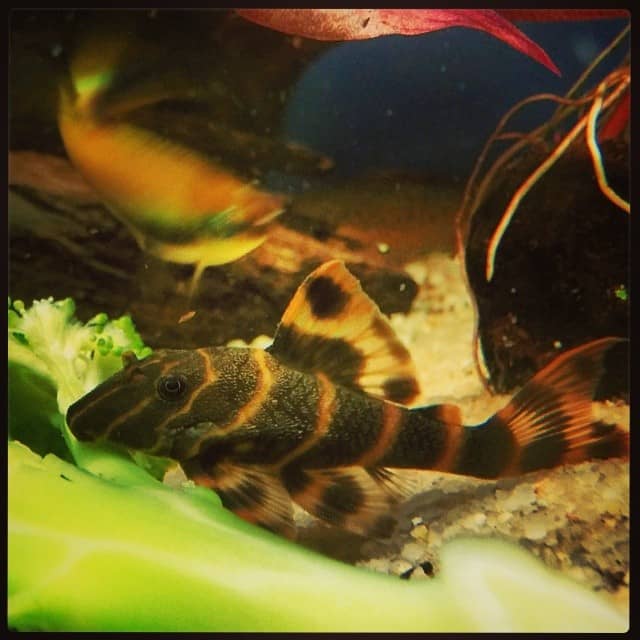
Heater
Can plecos live without a heater?
A heater may not be necessary if you live in an area that stays above 72 degrees Fahrenheit. Otherwise, your tank should have one.
Originating from the Amazon tropics, it is only natural for these fish to thrive in warm water.
Your catfish will do fine without a heater for a little while. But if the temperature gets too cold for a lengthy period, they would get sick and exhibit the following symptoms:
- Lethargy
- Slow metabolism
- Weakened immune system
That’s why it would be best to install a heater to ensure the water remains on the warmer side of the temperature range.
Filter
Clown Plecos have a huge appetite. These scavengers excrete a lot of waste for their size. That said, it is impossible to keep their tank clean without a filter.
I would suggest a strong canister filter for a 40-gallon tank, especially if you are considering a community setup.
But if you’re keeping a single Clown Pleco alongside a limited number of little schooling fish in a 30-gallon tank or smaller, a hang-on-back filter may suffice.
Oxygenator
To facilitate gas exchange, you’ll want to add one or two air stones for a 50-gallon tank. A canister filter is sufficient to circulate a tank of that capacity.
However, it would be wise to use a powerhead or wavemaker once you go above 50 gallons. As for the circulation rate, it will depend on the size of your tank.
For a normal freshwater setup, the pump should be able to cycle the entire tank water four times per hour. So if you have a 75-gallon tank, you’ll need a pump rated 300 GPH (75×4).
Aquarium Test Kits
Aquarium water upkeep cannot be accomplished without ammonia, pH, nitrite, and nitrate water test kits. Make sure to keep a log of all the testing that you do so that you have a record of what has been happening over time.
Water Parameters
Clown Plecos are resilient. Beginners need not worry about making a few errors in the water parameters. However, failure to meet the ideal water parameters is detrimental to even the hardiest of fish.
Water Temperature
The best water temperature for Clown Plecos is anywhere between 72 to 80 degrees Fahrenheit (22°-27° Celsius) achieved with or without a heater.
Water Flow Rate
Clown Plecos will do fine without strong currents, but there are advantages to adding a powerhead or wavemaker in your tank. For one, it improves oxygen levels and these catfish do require highly oxygenated water.
Water Hardness and PH
Keep the pH level of the water anywhere between 6.8 to 7.6 to replicate the natural habitat of the fish. As for the water hardness, keep it under 10 dGH.
Aside from testing the hardness and alkalinity, check your tank for ammonia, pH, nitrite, and nitrate. Perform these tests at least once a month. Likewise, make partial water changes per week.
Clown Pleco Diet and Feeding
Many beginning hobbyists are misguided about the dietary requirements of the Clown Pleco.
True, Clown Plecos are scavengers for the most part. And in terms of algae eating, the species rivals the Bristlenose Pleco.
However, these hardy catfish are not just cleaner fish that should rely on morsels and algae to survive.
While these oddballs appreciate having driftwood to snack on, you must provide commercially prepared foods to ensure they grow healthy and plump.
Here are some tried-and-tested recommendations for Clown Plecos:
Clown Plecos also relish vegetables, such as cucumber, lettuce, zucchinis, and green beans. Occasionally, you’ll want to provide your catfish with meat-based foods, such as bloodworms and daphnia as snacks.
Clown Pleco Tank Mates
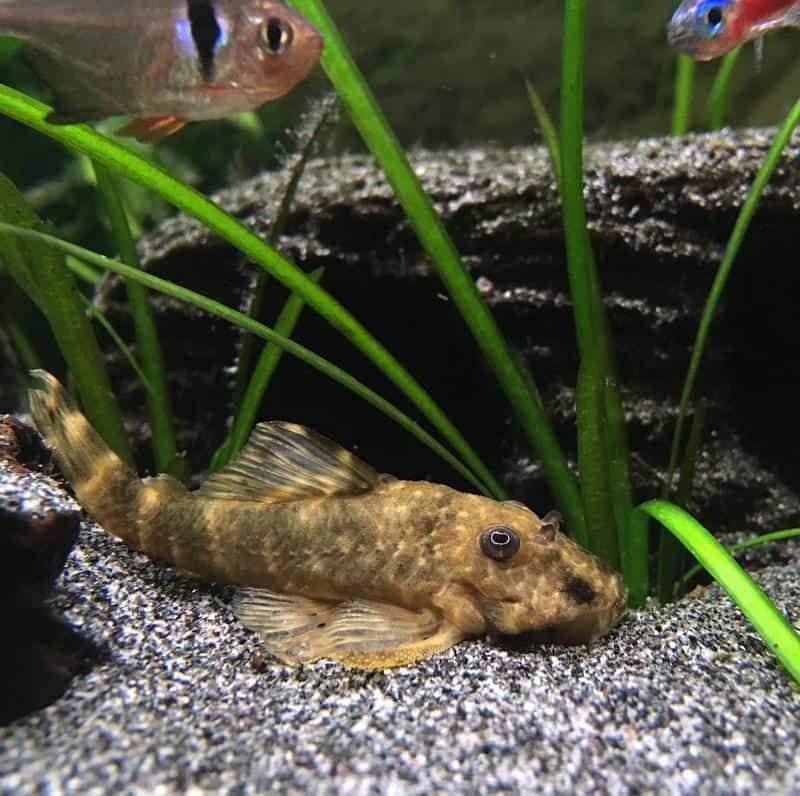
When it comes to choosing tank mates, you are pretty much in luck. The P. maccus is compatible with a myriad of freshwater species.
Here are some of the best tank mates for Clown Plecos:
- Angelfish (Pterophyllum scalare)
- Bala Shark (Balantiocheilos melanopterus)
- Electric Blue Acara (Andinoacara pulcher)
- Ember Tetra (Hyphessobrycon amandae)
- Cory Catfish (Corydoras panda)
- Dwarf Gourami (Trichogaster lalius)
- Jewel Cichlid (Hemichromis bimaculatus)
- Zebra Danio (Danio rerio)
Rasboras (Galaxy, Harlequin, Lambchop, etc.) and livebearers (Fancy Guppy, Platy, Swordtail, etc.) also make fantastic tank mates for the Clown Plecostomus.
Fish to Avoid
Crayfish and aggressive species of cichlids would seriously hurt Clown Plecos. You should also avoid territorial bottom-feeding fish that will compete with the plecos for space and food.
Clown Pleco Breeding
Clown Plecos are among the few species of freshwater fish that can breed successfully in captivity.
A pair will breed spontaneously in a community tank given the water conditions are constant and there is a suitable nook for the female to lay its eggs. But until Clown Plecos reach a certain age, they cannot breed.
Clown plecos mate by luring their females into caves, where they lay their eggs. The male fertilizes these eggs, monitors their development, and wards off potential threats. The eggs usually take between 3 to 10 days to hatch.
Common Diseases in Clown Plecos
If you dive into forums and social media platforms, you’ll find many hobbyists confused as to why their Clown Plecos died out of the blue.
Malnutrition
Strangely enough, starvation is the leading cause of death in Clown Plecos.
A common misconception about cleaner fish is that algae are sufficient for their needs. While Clown Plecos do eat algae, it shouldn’t be the staple of their diet when raised in captivity.
Make sure that the top and middle dwellers don’t hog all the food as they sink down. Feed floating food first to your top- and middle-level fish before dropping food to your lowest-level fish.
You should also be generous with food. You want their bellies looking round, not bulging or sunken.
If you are feeding adult Clown Plecos the same amount you give them when they were younger, they would surely get undernourished.
Constipation
A diet lacking in fiber can constipate Clown Plecos. Frequent feedings of protein-rich food are also problematic for your omnivorous fish.
Constipation can immediately kill your fish. Avoid this problem by feeding your plecos more plant-based food or vegetables.
Read More:
FAQs
Do Clown Plecos Clean Tanks?
No, Clown Plecos don’t clean tanks, but they can help keep algae growth at bay.
Can Clown Plecos Live with Betta Fish?
Yes! Although the Siamese Fighting Fish is notorious for being highly territorial and aggressive, it is less likely to attack the indifferent pleco.
Do Clown Plecos Eat Shrimp and Snails?
Clown Plecos might be gluttons, but these omnivores won’t commit a killing spree. They don’t prey on mollusks. So if you want to keep a Mystery Snail (Pomacea bridgesii), feel free to do so!
And if the tank is large enough, Clown Plecos and shrimps (Ghost, Red Cherry, and Amano) can coexist. However, the peaceful catfish may snack on baby shrimps.
Are Clown Plecos Aggressive with Their Own Kind?
If you want to keep two or more Clown Plecos, I recommend getting a much bigger tank. Equally important, place more rock ledges and caves so that the plecos can get away from each other and avoid unnecessary encounters.
While the P. maccus is not aggressive to other species, they can be territorial with their own kind. Therefore, you want to make sure there are enough hideaways for each fish.
Final Words
So, are you excited to care for a Clown Pleco? This armored catfish is quite hardy, which makes it a practical choice for beginners.
Clown Plecos are quite forgiving if you make minor mistakes, but that doesn’t mean you should stay inattentive to their specific needs.
For one, these omnivores need a high-fiber diet to stay in tip-top condition and tune in their diet as they grow.
Another thing to be aware of is that they expel a lot of waste. That’s why you need to invest in a high-quality canister filter.
With proper care, the species can live for a decade; hence you can make many memories looking after your pet fish.